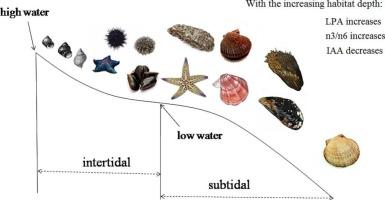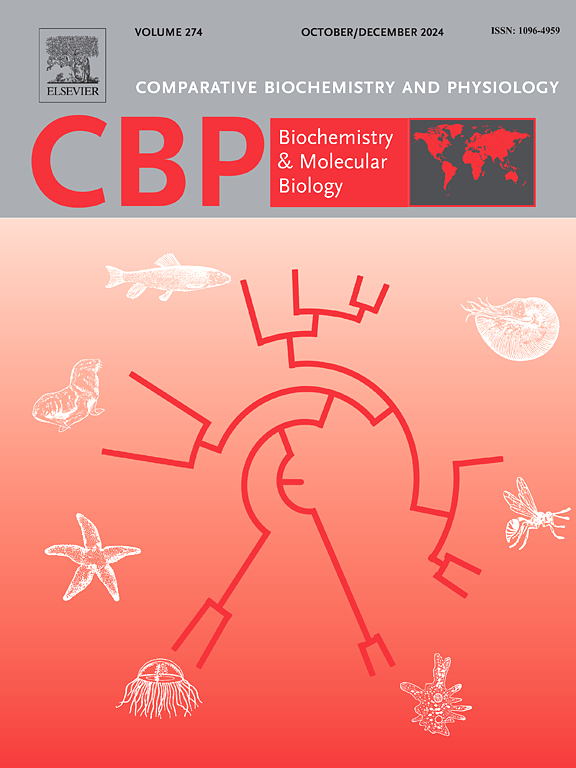海洋无脊椎动物脂类在体外促氧化条件下对氧化的比较敏感性。
IF 1.8
3区 生物学
Q4 BIOCHEMISTRY & MOLECULAR BIOLOGY
Comparative Biochemistry and Physiology B-Biochemistry & Molecular Biology
Pub Date : 2025-06-26
DOI:10.1016/j.cbpb.2025.111121
引用次数: 0
摘要
本研究比较了Fenton试剂(硫酸亚铁和过氧化氢)对13种海洋无脊椎动物(软体动物和棘皮动物)消化组织匀浆的氧化损伤程度。脂质过氧化(硫代巴比妥酸反应物质,TBARS)被用来评估研究生物对脂质过氧化的潜在抗性。这些数据表明,无脊椎动物可以分为两类。第一组包括海胆和腹足类软体动物,它们具有高水平的综合抗自由基活性(IAA)和低水平的过氧化脂质(LPA)。第二组包括海星和双壳类动物,它们的IAA含量低,LPA含量不同。在这些数据的基础上,假设占据上滨海和潮间带的物种(海胆、腹足类软体动物),暴露于影响代谢过程的因素波动中,从而改变活性氧的水平,通过高抗氧化潜力适应这种环境。相反,在更稳定的条件下生活在更深水域的物种(双壳类,海星)不需要维持高浓度的低分子量抗氧化剂。这可能代表了这些物种对其自然栖息地环境波动的重要适应。本文章由计算机程序翻译,如有差异,请以英文原文为准。

Comparative sensitivity of marine invertebrate lipids to oxidation under prooxidant conditions in vitro
The current study compared the degree of oxidative damage induced by Fenton reagents (ferrous sulfate and hydrogen peroxide) in the digestive tissue homogenates of 13 species of marine invertebrates (mollusks and echinoderms). Lipid peroxidation (thiobarbituric acid reactive substances, TBARS) was used to estimate the potential resistance to lipid peroxidation in the studied organisms. These data showed that invertebrates can be divided into two groups. The first group included sea urchins and gastropod mollusks, which had a high level of integrated antiradical activity (IAA) and a low level of lipids available for peroxidation (LPA). The second group included sea stars and bivalves, which have low levels of IAA and varying amounts of LPA. On the basis of these data, it is hypothesized that species occupying the upper littoral and intertidal zones (sea urchins, gastropod mollusks), and which are exposed to fluctuations in factors that affect metabolic processes and thus alter the levels of reactive oxygen species, are adapted for such settings through a high antioxidant potential. Conversely, species that inhabit deeper waters under more stable conditions (bivalves, sea stars), do not need to maintain a high concentration of low-molecular-weight antioxidants. This may represent an important adaptation of these species to environmental fluctuations in their natural habitats.
求助全文
通过发布文献求助,成功后即可免费获取论文全文。
去求助
来源期刊
CiteScore
4.60
自引率
4.50%
发文量
77
审稿时长
22 days
期刊介绍:
Comparative Biochemistry & Physiology (CBP) publishes papers in comparative, environmental and evolutionary physiology.
Part B: Biochemical and Molecular Biology (CBPB), focuses on biochemical physiology, primarily bioenergetics/energy metabolism, cell biology, cellular stress responses, enzymology, intermediary metabolism, macromolecular structure and function, gene regulation, evolutionary genetics. Most studies focus on biochemical or molecular analyses that have clear ramifications for physiological processes.

 求助内容:
求助内容: 应助结果提醒方式:
应助结果提醒方式:


